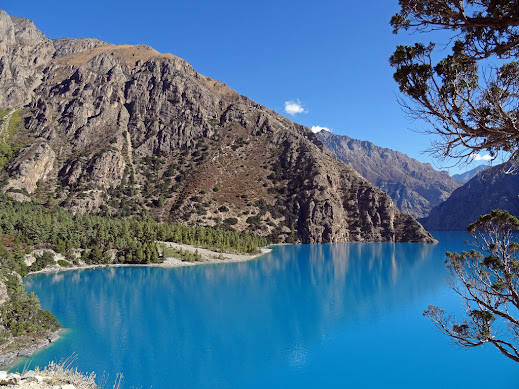Tara is one of the most worshipped deities among Buddhists in Asia. Among the five Tara Goddesses - White, Yellow, Blue, Red, and Green, the Green Tara is most popular. From Nepal to India, China, Japan and other Buddhist countries, her powerful and compassionate figure adorn the walls of many homes.
My fascination with the Goddess started with a painting of Green Tara by Samudra Man Singh Shrestha displayed at the Museum of Nepali Art. A surreal green figure adorned with the most exquisitely crafted jewels draws the attention of all men and women. A coy look, a subtle seductive posture and magnetic yet soft eyes portray Tara as the most beautiful Goddess ever in the artists’ presentation. Vajrayana Buddhism Goddesses are truly an artists’ delight as most of them are imaginary figures, giving the artists - especially present day neo traditional ones - the freedom to create a heavenly figure of astounding beauty.
But what is the history of this goddess who is so revered by Mahayana and Vajrayana sects all over the Asian continent? While some scholars believe the interlocking of Vajrayana sect with Hinduism created several manifestations of deities to make converts worship Buddhist versions of Hindu Gods, others believe deities have their origin in Buddhism itself.
The difference between Hindu and Vajrayana Buddhist deities is that most Hindu gods and goddesses were mortals elevated to godly status with their exceptional life stories and good action. Buddhist deities, on the other hand, are mostly imaginary figures given a form to fulfill various religious needs and represent symbols similar to their Hindu counterpart.
Hinduism’s innumerable gods and goddesses portray every human characteristic and need, and are an icon of worship to solve every problem under the sun. In Vajrayana Buddhism too, there are a number of Bodhisattvas -ones who take the path to enlightenment but delay attaining it so as to help alleviate the suffering of other sentient beings - whose presence bear a parallel to the Hindu pantheon.
There are some mortal bodhisattvas such as Manjushree and Padmasambhav, but most of them are imaginary figures. One such revered figure is the Green Tara.
Some scholars believe Tara’s origin to be traced to Hindu tantric literature and the Puranas (Hindu religious scripts). According to scholar Hirnanda Shastri, the name Tara is found in Brahmanic literature as a synonym for Goddess Durga. She is described as Tara Amba (Mother Tara), the Patron of the Seas. Tara devotees consisted mainly of trading sailors, navigators and boatmen because the Puranas describe her as related to water bodies. She is named after the star “Dhruva Tara” as it is the main star that guides the sea journeys. It is thus explained by Hindu scholars that Goddess Tara got a place in Hindu theology before the 5th century, as a patron of the seas. It is also possible that Hindus who converted to Buddhism brought their Hindu deities along and had them assimilate into Buddhism in the course of time.
The Buddhist version of Tara’s origin story says that she came into existence in the 5th century and the Hindus accepted her into the group of Shakti (feminine energy) goddesses. Tara’s earliest images, found in the Buddhist caves of Western India, date back to the 6-7th centuries suggesting the influence of the Shakti cult in Mahayana and Vajrayana Buddhism. Her first appearance in the coastal caves of the northern Deccan region and western India reinforces this status as the protector goddess of the seas.
The Buddhist mythological version says she originated from the tear of Avalokiteshvara (male bodhisattva of compassion), which fell on to the ground and formed a lake. Out of its waters rose a lotus, which upon opening revealed the Goddess. Tara was thereafter known as the female equivalent of Avalokiteshvara,a compassionate deity who helps men “cross over to the other shore.” Her emergence as a Bodhisattva thus can be seen as an attempt of Mahayana Buddhism to become more gender inclusive.
In Tibet, Green Tara manifests in the form of Nepali Princess Bhrikuti. The Licchavi Princess Bhrikuti Devi (7thcentury AD), who married King Tsongtsen Gampo of Tibet, had a big role in exporting the essence of Vajrayana Buddhism from Nepal to its neighbors, and was thus elevated to the celestial status of Bodhisattva Tara. The Tibetan king is believed to have sought for the Nepali princess as he was enchanted with the development of Buddhism in Nepal and wanted to introduce similar civilized culture, arts and architecture to Tibet.
Whichever way you choose to look at the Green Tara -as a patron of the seas, the feminine bodhisattva of compassion, or in manifestation as Princess Bhrikuti Devi, the goddess captures you with her divine mystery. Unlike Hindu goddesses with heart wrenching life stories such as Sita or Sati Devi, the Green Tara is just an imaginary figure that portrays divinity in its most beautiful form.
Not much is commonly known today of the origin of Green Tara, and her contemporary paintings rarely depict her as the protector of the seas. With Muslim invasions across the subcontinent from 11th century onwards, Buddhists escaped northward to Nepal and China, and with these changing religious landscapes, the Green Tara is usually portrayed in a backdrop of floating clouds, in the ‘tribhanga asana’ (a gracefully bent posture) or seated on a lotus pedestal. Her journey north from the sea coast to the mountains, synonymous with the star she represents - “Dhruva tara” – or the northern star, is yet another tale sidelined in mass consciousness, and yet another chapter of “Herstory,” of a prominent goddess of the Asian continent.
References:
1. Goddess Tara, a short study – Jagdish Chandra Regmi
2. Iconography of Buddhist deities – Min Ratna Bajracharya




